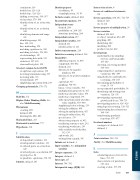Page 946 - Algebra 1
P. 946
continuous, 118
double-bar, 128–129 double-line, 128–129
finding zeros from, 586–587
of functions, 179–180 identification of, as a function,
148
identification of, as a relation,
148
identifying domain and range,
181
identifying range, 181
line, 128–129
line, misleading, 159 matching equations to, 180 matching to tables, 179–180 of relationships, 117 representing data with, 525 statistical, 127–128
stem and leaf plots, 128
Greatest common factor (GCF)
of algebraic expressions, 238 factoring trinomials using, 517 factoring with, 571
of monomials, 237
simplifying expressions with, 239 Grouping polynomials, 570–571
H
Half-life, 751
Higher-Order Thinking Skills. See
also Math Reasoning
Histograms
creating, 408 defined, 408
drawing lab, 404–405
Horizontal lines, 258 Horizontal translations, 777 Hypothesis, 254
I
Identification
of dependent variables, 111
of independent variables, 111 of ordered pairs, as a function,
147
of ordered pairs, as a relation, 147 of properties, 64
of quadratic equations, 550–551
Identity, defined, 165
Identity property
of addition, 63
of multiplication, 56, 63
Inclusive events, defined, 444
Inconsistent equations, 436
Independent events
defined, 204
probability of, 204–205 situations involving, 204
Independent system, 437
Independent variables, 146 defined, 111
identification of, 111
Indirect measurement, 224 Inductive reasoning, defined, 254
Inequalities
addition property of, 430 compound, 481–482 defined, 282
division of, by negative
numbers, 458
division of, by positive numbers,
457
equivalent, 315
graphing, 314–315
linear, of one variable, 314 multiplication property of, 455 multi-step absolute-value, 678 multi-step compound, 538
with operations inside absolute-
value symbols, 679–680 simplifying before solving, 533 solving by addition, 430 solving by multiplication, 455 solving by subtraction, 432 special cases, 533
subtraction property of, 432 translating sentences into, 282 translating words into, 283 with variables on both sides,
532–533
and words, 282
writing from a graph, 316
Infinite set, defined, 2
Input variables. See independent
variables
Integer exponents, 324 Integers, defined, 2 Intercepts, 217
Interest, 788–792 Interquartile range (IQR), 346
Intersection of sets, 4
Inverse of conditional statements,
321
Inverse operations, 104, 165, 712–713 defined, 120
use of, 121
Inverse property of multiplication, 56
Inverse variation
defined, 418, 462
vs. direct variation, 462–463 graphing, 420
identifying, 419
modeling, 418
product rule for, 419
Investigations
analyzing bias in sampling, surveys, and bar graphs, 187–189
choosing a factoring method, 598–601
comparing direct and inverse variations, 462–463
using deductive and inductive reasoning, 254–256
determining probability of event, 53–54
on experimental probability, 54 identifying and writing joint
variation, 529–531 investigating exponential
growth and decay, 749–753 investigating matrices, 826–829 using logical reasoning, 320–321 transforming linear functions,
396 –399 transforming quadratic
functions, 676–677
Irrational numbers
conjugate of, defined, 693 defined, 2
J
Joint variations, 529–531 Justify. See Math Reasoning
L
Labs
calculating intersection of two lines, 352–353
characteristics of parabolas, 583–584
creating a table, 177–178
Index 931
INDEX


